Do you have a question about the Harman Kardon AVR35 and is the answer not in the manual?
Welcome message and overview of the Harman Kardon AVR35's capabilities and user-friendly design.
Details on the AVR35's full-featured A/V receiver capabilities, including Dolby Digital, surround modes, and input flexibility.
Essential safety guidelines covering voltage, extension cords, cabinet access, grounding, and installation location.
Highlights critical electrical safety symbols and warnings to prevent shock and fire hazards.
Instructions for cleaning, moving the unit safely, and FCC compliance details.
Guidance on handling packaging materials and understanding manual's typographic conventions.
Diagram illustrating and numbering all controls on the front panel of the AVR35.
Numbered list detailing the function of each control on the AVR35's front panel.
Explanation of the Main Power Switch and Power Indicator's function and status.
Details on using Bass, Treble, and Balance controls for sound customization.
Functions of buttons used to select various audio and video input sources.
Operation of the AM/FM tuner, tuning buttons, and the sleep timer function.
Controls for selecting preset stations, tuner modes, and various analog surround sound modes.
Explanation of controls for Dolby Digital, Pro Logic, Test Tone, Mute, Delay, and digital input selection.
Controls used for system setup, speaker configuration, and channel adjustments.
Description of the Information Display and the function of the Remote Sensor Window.
Diagram showing the arrangement of indicators and segments on the front panel display.
Key explaining the meaning of indicators A through S on the front panel display.
Explanation of the 'T' indicator on the front panel display.
Explanation of indicators related to audio input sources and surround modes.
Details on indicators for analog surround modes and the Night mode feature.
Indicators related to tuner status, preset memory, and system operation.
Explanation of the Main Information Display and the Sleep function indicator.
Diagram illustrating and numbering all rear panel input and output connections.
Details on connecting antennas and audio/video sources like CD and DVD players.
Connections for video output and connecting a powered subwoofer.
Guide for connecting front, center, and surround speakers to the rear panel terminals.
Detailed explanation of connecting speakers to the front, center, and surround terminals.
Information on using the Switched and Unswitched AC outlets for accessory devices.
Details on connecting digital and analog sources and outputting video to a TV.
Connections for remote control extension and tape recorder input/output.
Diagram illustrating and numbering all buttons on the remote control.
Numbered list detailing the function of each button on the remote control.
Instructions on programming the remote for other devices and selecting the AVR35.
Explanation of commonly used buttons like Power, Sleep, Channel, Surround, and Volume.
Functions of buttons used for system setup, Night Mode, and source selection.
Usage of numeric keypad and the +10 button for various functions.
Functions of Info, Clear, Memory, Tuner Mode, and Direct buttons for tuner operation.
Controls for tuning stations, navigating presets, and operating transport functions.
Controls for digital input selection, speaker configuration, and muting audio output.
Functions of Volume, Test, and TV/VCR buttons on the remote control.
Steps for setting up the receiver after unpacking, including making connections.
Guide for connecting audio source equipment like CD players and tape decks.
Instructions for connecting digital audio sources via Optical and Coaxial inputs.
How to connect FM antennas and speaker outputs, including cable recommendations.
Guidance on speaker polarity and selecting appropriate speaker cable gauge.
Instructions for connecting the AVR35 to powered or passive subwoofers.
Connecting VCRs, satellite receivers, DVD players, and TV monitors to the AVR35.
Connecting external components and final AC power connection to the AVR35.
Importance of correctly configuring the AVR35 for optimal listening experience.
Recommendations for selecting matching speakers and their optimal placement for sound quality.
Detailed guidance on positioning the front left, center, and right speakers for best sound.
Advice on placing surround speakers and subwoofers for optimal effect.
Steps for powering on the AVR35 and installing batteries in the remote control.
Guide to configuring speaker settings (LARGE/SMALL) for bass management.
How to select LARGE or SMALL for front speakers based on their low-frequency capability.
Configuring the center speaker setting (SMALL, LARGE, NONE) for optimal bass management.
Setting the surround speaker configuration (SMALL, LARGE, NONE) for proper audio routing.
Selecting whether a subwoofer is connected (S-W SPEAKER ON/OFF) for bass redirection.
Procedure for adjusting individual speaker output levels using the test tone for calibration.
Adjusting output levels using program material and the volume control for fine-tuning.
How to use the test tone to verify speaker connections and balance sound levels.
Explanation of delay settings for synchronizing sound arrival from different speakers.
Formula and examples for calculating optimal delay times for Dolby Digital surround.
Formula and examples for calculating optimal delay times for Dolby Pro Logic surround.
Step-by-step instructions for entering calculated delay times into the AVR35.
Procedure to set the delay time for the center channel, especially for digital sources.
Steps to select a digital input source before adjusting delay settings.
Concluding the setup process, including saving settings and readiness for enjoyment.
Steps for turning the unit on/off and selecting audio/video input sources.
Adjusting audio levels, selecting listening modes, and setting the sleep timer.
Guidance on choosing surround modes based on program source and personal preference.
Specific details on Dolby Digital, Pro Logic, and Stereo modes, including features and delay times.
How to select surround modes via remote and choose digital input types (Coaxial/Optical).
Details on Dolby Digital technology, its channels, and connecting digital audio sources.
Explanation of Dolby Digital display messages and compatibility notes.
Specifics for laser disc Dolby Digital playback and PCM audio playback.
Selecting surround modes for PCM playback and operating the tuner for station selection.
How to store and recall preset stations and perform tape recording.
Adjusting speaker output levels using program material for precise calibration.
Information on the memory backup system for presets and configuration data.
Steps to reset the AVR35's memory and microprocessor in case of abnormal operation.
Overview of the remote's ability to control various audio/video devices.
Easiest method to program the remote by entering three-digit codes for specific brands.
Procedure for automatically searching for and entering remote control codes.
Detailed steps for using the Auto Search method to program remote codes.
How to read and verify entered remote control codes.
Explanation of how buttons function when controlling programmed devices.
How to find button functions for specific devices using the Function List.
Introduction to programming the Power button to send a sequence of commands.
Step-by-step instructions for programming macro sequences into the remote's Power button.
Example demonstrating how to program a macro for turning on multiple devices.
How to program the remote so volume controls work across different devices.
Procedure for re-assigning device control buttons to operate different types of equipment.
List of button functions for the AVR35 and CD players.
List of button functions for Tape decks and DVD players.
List of button functions for LD players and the numeric keypad.
List of button functions for controlling TV sets and VCRs.
List of button functions for VCRs and Cable boxes.
List of button functions for Satellite receivers.
Setup codes for programming the remote to control TV brands starting with A through F.
Setup codes for programming the remote to control TV brands starting with G through J.
Setup codes for programming the remote to control TV brands starting with J through P.
Setup codes for programming the remote to control TV brands starting with P through R.
Setup codes for programming the remote to control TV brands starting with R through Z.
Setup codes for programming the remote to control VCR brands starting with A through H.
Setup codes for programming the remote to control VCR brands starting with H through N.
Setup codes for programming the remote to control VCR brands starting with O through S.
Setup codes for programming the remote to control VCR brands starting with S through Z.
Setup codes for programming the remote to control CD players from brands A through Y.
Setup codes for programming the remote to control LD players.
Setup codes for programming the remote to control DVD players.
Setup codes for programming the remote to control Cable boxes.
Setup codes for programming the remote to control Satellite receivers.
Solutions for common problems like no front panel lights or no sound/picture.
Solutions for issues like no sound from speakers, no remote response, or tuner buzzing.
Resolving problems with surround sound, mono input, or incorrect configuration.
Detailed specifications for the audio output, including power, THD, and sensitivity.
Technical details of the FM and AM tuner performance, including sensitivity and selectivity.
Specifications for video performance, power requirements, dimensions, and weight.
| Type | AV Receiver |
|---|---|
| Impedance | 8 ohms |
| Frequency response | 20Hz - 20kHz |
| Total Harmonic Distortion | 0.07% |
| Signal to noise ratio | 100dB |
| Input Sensitivity | 200mV |
| Input Impedance | 47k ohms |
| Tuner | AM/FM |
| Power output | 50W per channel |
| Video inputs | Composite, S-Video |
| Audio inputs | Digital Optical, Digital Coaxial, Analog Audio |
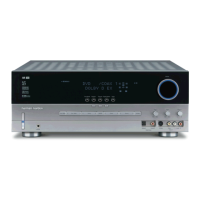
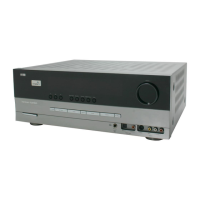
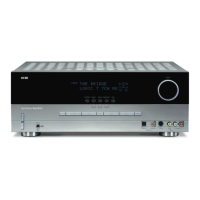
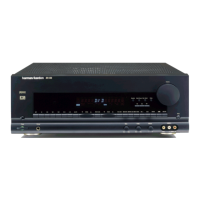
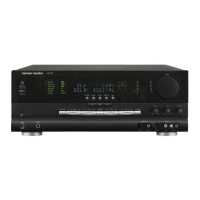
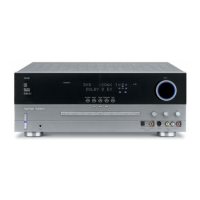

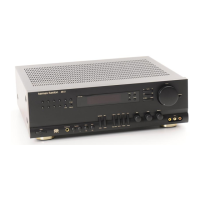

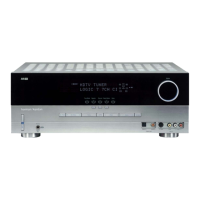
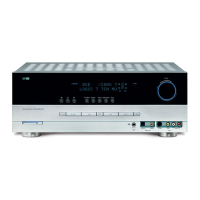

